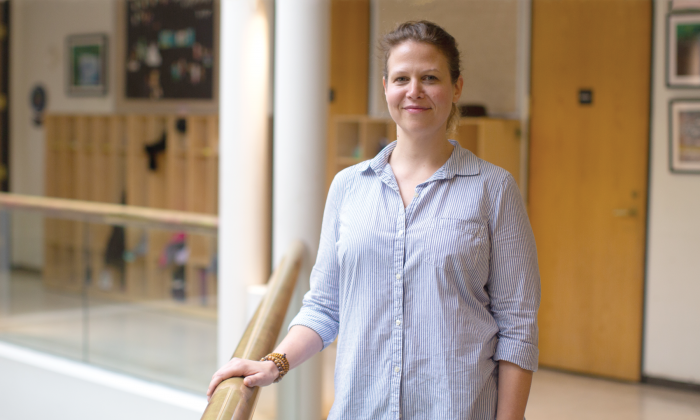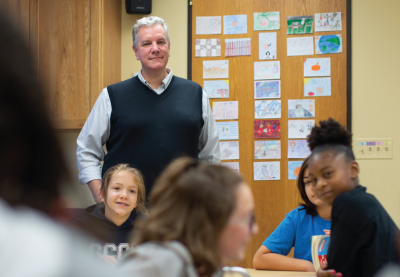Editor's note: This story references the previous TT Grants program. For information on the current LFJ Educator Fund, click here.
When Chris Dolgos noticed upscale boutiques cropping up in Rochester, New York’s trendy South Wedge neighborhood, he knew there was more going on in his city than just gentrification.
Rochester’s downtown revitalization allowed Dolgos, a longtime resident of the area and teacher at Genesee Community Charter School, to wander through coffee houses, salons and eclectic gift shops; his sixth-graders could visit new ice cream stores and sample organic produce at the Rochester Public Market with its brand-new, state-of-the-art, indoor pavilion. But, at the same time, Dolgos’ class knew about residents having to move out of their homes because they could no longer afford to live in their neighborhoods.
“People want to live in the South Wedge or the East End,” relays Dolgos. “It’s displacing people who’ve lived there for so long because landlords are realizing they can jack up the rent.”
The rents had been low because Rochester, much like Detroit and other Rust Belt cities, had been a city in decline. Once a hub for manufacturing giants like Xerox, Kodak and Bausch + Lomb, the industrial center declined in the last two decades of the 20th century as companies downsized. The city lost many major businesses, jobs and much of its population. But, more recently, Rochester’s medical, arts, communications and education sectors have attracted millennials back to the city. Its downtown population has more than doubled in the last 15 years.
While Dolgos welcomed downtown’s newfound prosperity—what some have dubbed an “urban renaissance”—he continued to wonder about Rochester’s other neighborhoods. He decided to explore the idea with his students.
“We talked about the downtown renaissance: the new restaurants, the stores, our expanding children’s museum with its proposed nearby affordable housing units,” he says. “The city of Rochester is doing a lot of big things, but it always comes back to, ‘Are we doing enough for the people who need it the most?’”
What followed was a year-long expedition into Rochester’s renaissance, which Dolgos and his co-teacher, Alexis Stubbe, devised at their EL Education school. The project, partly supported by a Teaching Tolerance Educator Grant, explored how the city has reinvented itself after decades of economic downturn. Students investigated the ways the city’s renaissance has included some residents while simultaneously excluding others. “Our students are perfectly poised to examine the neighborhoods they call home, identify what works and what doesn’t in their communities, and collaborate with local and national experts to make sure our city’s renaissance is an inclusive one,” Dolgos explains.

Exploring Barriers and Bridges
To better understand their community’s identity, the class investigated their own identities—and those of their fellow residents. Dolgos and Stubbe framed their expedition as an inquiry into the question, “Whose renaissance is it, Rochester?”
The entire project was centered around the theme of “barriers and bridges”: barriers being anything holding back individuals and communities, and bridges being anything bringing them together.
The class launched into a three-mile walking tour through neighborhoods in their city. They took note of physical barriers like railroad tracks and the Inner Loop, a 1950s freeway expansion project that cut swaths of residential zones off from downtown and cleaved the city in two. Students also noticed experiential barriers like homelessness, gun violence and poverty. At the same time, the class pointed out bridges—physical ones, like the Erie Canal aqueduct, and metaphorical ones, like public art, community gardens and murals.
Students noticed disparities in neighborhoods’ amenities right away. As Dolgos recalls, “They posed a lot of questions like, ‘Why are there soup kitchens here?’ ‘Why are these corner stores filled with this kind of food?’ ‘Why is there garbage on the ground here, but not in another part of the city?’ Kids picked up on these things and asked about who’s getting the benefit and who’s being taken advantage of.”
Rowan Nordquist, one of Dolgos’ sixth-graders, reflects on growing up sheltered from much of the city’s poverty and crime: “Once you step outside my neighborhood, you see the real world. I was basically living in a reality where everything was perfect, but now I’m moving out into the real world. … I had not seen it before. It’s really different.”
Dolgos and Stubbe wanted to explore the notion that cities, just like people, have malleable, fluctuating identities. To do so, they integrated the Teaching Tolerance Social Justice Standards into their curriculum, organizing their syllabus around the Standards’ four anti-bias domains: Identity, Diversity, Justice and Action. The lessons began with an inward investigation of identity and progressed in sequence through the last three domains. (Learn more about the Identity domain in PD Café on page 15.)
“The standards helped us to focus on questions of who we are as people and do we really understand ourselves,” Dolgos remembers, “because before we can understand the people living on the west side or the north side of the city, we need to know who we are and where we come from.”
Do you have an idea for a social justice project? Apply for help from the LFJ Educator Fund!
To further explore the topic of personal identity, the class collaborated with teaching artist Almeta Whitis. This is where support from the TT grant came into play. Whitis, a storyteller with literary arts nonprofit Writers & Books and former performing arts professor, helped students compose monologues of self-expression. Rowan, for example, depicted a tumult of inner struggle. In his monologue, titled “I Am a War Inside,” he wrote, “A battlefield exists inside me. It is a war to balance my heart and mind.”
The Story’s in the Numbers
The course expanded outward, delving into the identities of the school, students’ communities and, finally, into their city. To examine the next two domains of the Social Justice Standards—Diversity and Justice—the class reviewed demographic data for Rochester and explored how the numbers told the story of a community.
Students discussed literacy, poverty and health disparities across demographic groups. They examined the statistics behind redlining—duplicitous tactics employed by the banking and real estate industries to keep people of color out of certain neighborhoods or to keep them from becoming homeowners. The class discussed how discriminatory practices segregate communities by income and race.
“We looked at poverty rates and census data about where the poverty rates occurred,” recalls Dolgos. “The kids could see a correlation between poverty and race. They said, ‘Why is it like this?’ ‘How’d it get like this?’ There are a lot of things that people talk around, but nobody wants to address the root causes of poverty and systemic, institutional racism.”
Dolgos, Stubbe and their students examined the report Hard Facts by ACT Rochester—an organization dedicated to community problem-solving—to dig deeper into the enduring link between poverty and race.
Ann Johnson—ACT Rochester’s director and a guest lecturer in Dolgos’ classroom—explained that, while nationally African Americans earn just 62 cents for every dollar their white counterparts earn, in Rochester it’s only 48 cents.
“How could we be so different from the United States when, as a region, we’re pretty similar? We looked at the life cycle of a person, from infant mortality to reading and unemployment rates,” Johnson says. “We found that people of color do not have the same results throughout their life as their white counterparts.”
Once they got a good handle on the problems, the class began thinking about solutions. They met with community members devoted to removing achievement barriers for all Rochesterians. Kevin Kelley, a city planner, spoke with students about the city’s next development proposal, the comprehensive Rochester 2034 plan. Kelley and the students reviewed the successes and challenges of Rochester 2010: The Renaissance Plan, and discussed the tension between planning for the future of all city residents and working with limited available resources.
Listening as Learning
Students next set out into the city. They spoke with Rochester residents about the strengths and challenges of their surroundings. Sensitive to entering communities that were not their own, students made sure to keep respectful listening top of mind. “You don’t make judgments; you don’t take action. You’re just listening,” Dolgos explains. “We have to listen to people’s stories and honor their truth.”
We have to listen to people’s stories and honor their truth.
From Rochester, students then embarked on their “Four Cities” tour, splitting up to visit Oakland, Detroit, Pittsburgh and New Orleans—all places experiencing recent urban renaissances. They met with community organizations to learn about their inclusive, equitable urban planning efforts. “The big word about that was equity,” says sixth-grader Rowan. “You have to fit everyone’s needs.”
In Oakland, for example, students met with staff members from The Greenlining Institute, a policy, research, organizing and leadership initiative for racial and economic justice.
Staff spoke with students about advocating for urban environments where communities of color thrive and race does not present a barrier to economic opportunity.
Painting a Positive Picture
The class capped off their year-long expedition with a city-wide art project, painting four murals across the city. They collaborated with guest artist Shawn Dunwoody, a lifelong Rochesterian and activist focused on community-based forms of urban development. Dunwoody connected students with business proprietors who had planted their roots in Rochester decades prior.
The students sought community input for the murals’ designs and messages, and students from four different schools even pitched in to help paint. Every mural featured an affirming message, including one from abolitionist Frederick Douglass, who once lived in Rochester: “It is easier to build strong children than to repair broken men.”
At Genesee Charter’s Exhibition Night, attended by community members, students’ families and a representative from city hall, the class presented their findings in a multimedia storytelling presentation featuring their project’s interactive website. The site includes photos from the mural project, student journalism, insights from the Four Cities tour and recommendations for how the city can foster an inclusive and equitable urban renaissance. They titled their presentation “Whose Renaissance Is It? A Closer Look at Rochester’s Renewal.”
Looking back, Rowan characterizes his experience of the year-long expedition as “eye-opening.” “Before this project, I had blindfolds on,” he recalls. “But then during the project, they lifted the blindfolds off of my face.”
Ehrenhalt is the school-based programs and grants manager for Teaching Tolerance.
